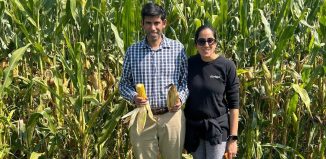BNL’s Paul O’Connor helps build the LSST
The world’s largest digital camera will help scientists ‘see’ dark matter, asteroids and much more
Paul O’Connor at Brookhaven National Laboratory is part of a team building a combination telescope and camera whose “wow” factor is off the charts. When the Large Synoptic Survey Telescope (LSST) is up and running in 2021, it will allow us to look deep into billions of galaxies, keep a close eye on nearby asteroids and even help us see so-called dark matter, which does not emit, reflect or absorb light.
The LSST will be the largest digital camera in the world, will survey a volume of the universe in its first week of operation larger than all previous telescopes combined, will take three-gigapixel photographs, and will survey the entire sky every three nights.
And, from its perch at 8,800 feet in Cerro Pachon in Chile, the LSST will monitor asteroids near the planet.
The telescope will make an “orbit determination for asteroids that may pose a threat from colliding with our planet,” O’Connor explained.
It will also be able to see dark matter, which comprises 25 percent of the universe, or 5 times more than things we can see, like puppies, the Olympic games and fireworks.
Here’s how it works: the telescope looks at light that comes from incredibly far away that was sent into space billions of years earlier. If there weren’t any dark matter, the light would take a direct route. Dark matter, however, causes the light to bend, as if it were going through a lens. How the light bends reveals the “clumpiness” of the dark matter. (If you’re wondering about the remaining 70 percent of the universe, that’s comprised of dark energy, a force that played a role in cosmic evolution and works against gravity, allowing the universe to expand.)
O’Connor is helping with the “film” part of the camera. The LSST will need over 200 charge-coupled devices, which process even the faintest of signals.
The charge-coupled devices will be arranged in a mosaic inside the telescope and have to be almost perfectly flat when lined up, with no more than a 10-micron tilt in any direction. The thickness of a human hair, by comparison, is 100 microns.
The LSST team has asked private companies to build these charge-coupled devices. When those are completed, the read out time on them will be 10 times faster than the state of the art in astronomy. One of O’Connor’s jobs is to test their work, to make sure they meet the requirements for the telescope.
“We give them our suggested design approach and then we let the companies provide a manufacturing method,” he offered. “When the prototypes come back, we have to verify that they’ve met the requirements. It involves a rigorous test protocol.”
O’Connor, who is the associate division head of the instrumentation unit at BNL, does considerable coordinating between scientists and the manufacturers. He can spend seven hours or more on teleconference calls, speaking with collaborators.
“It’s the nature of big science projects,” he explained. It’s required to keep “coherent, large collaborations functioning and communicating well.”
Assembling and testing the small parts necessary for this three-ton telescope requires clean rooms, where scientists have to wear full-body suits, masks and gloves.
Brookhaven has a clean room and is in the process of building another, which will be finished later this year. Its initial occupant will be the LSST project.
“Human beings are the worst actors in producing particles,” explained O’Connor. “We have to take precautions.”
O’Connor lives in Bellport with his wife Leslie, who is an elected trustee of the village.
The O’Connors have one daughter at Massachusetts Institute of Technology and another who is entering her final year at Bellport High.
When he’s not checking parts for the LSST, O’Connor enjoys kayaking and sailing in the Great South Bay.
As for his work, O’Connor explains that he is “charged to provide the next generation technology in the support of a science mission.” He enjoys the opportunity to work in a multidisciplinary effort. He has also worked on projects closer to home, including developing a process for screening for breast cancer that combines the best of positron emission tomography and magnetic resonance imaging.
“It’s very exciting and satisfying to be able to work in all those fields of cutting edge science,” he explained.






